Killifish is not very popular in aquarium husbandry and it is seldom sold in pet shops, though this is the brightest tank fish and a very fascinating one. Despite the fact that the fish is vivid and bright colored it’s not widely spread in aquarium husbandry. But it’s not only the rich coloring that makes this fish so attractive. It has rather unusual spawning habit, due to which the fish is called an annotinous one. The fish hatches, reproduces and dies in a period of about a year. In the wild the fish dwells in ephemeral waters, which dry up for a period that lasts about six months. The fishes grows, lays eggs and dies in a year. Though the fish eggs do not die and they stay in the ground till the next rainy season.
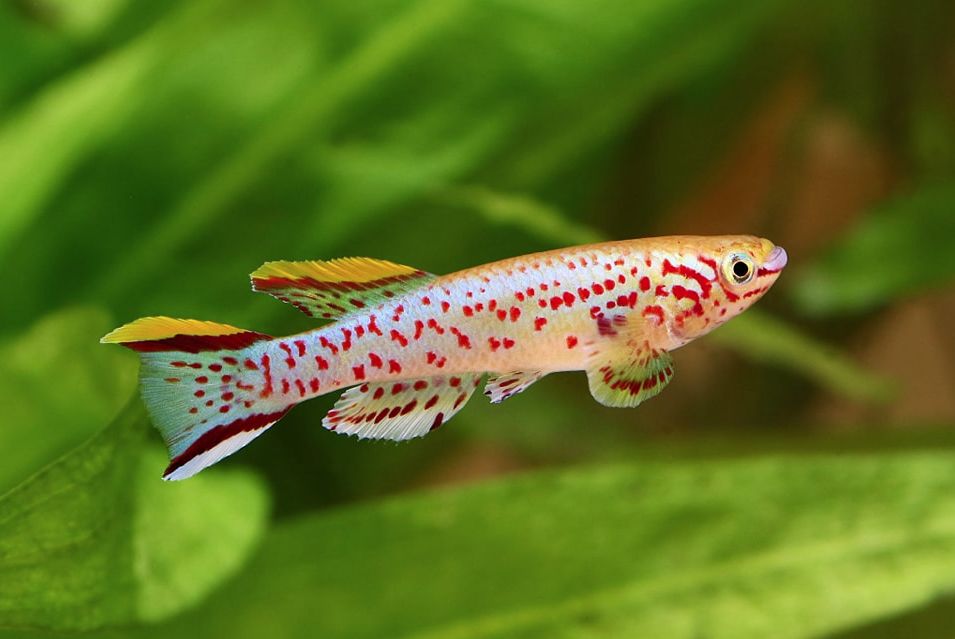
Contents
Habitat in the wild
Killifish is a common name for 5 families of cyprinodontoids fish species. These include:
- Aplocheilidae
- Cyprinodontidae
- Fundulidae
- Profundulidae
- Valenciidae
The number of some fish kinds in these families comprises about 1300 species.
The name killifish jars on ears due to its likeness with the verb ‘to kill’. However, there is no connection between these two words. The origin of the term is unclear, though it is supposed to develop from the Dutch word ‘kil’, which means a small stream.
Inhabits mainly in fresh and brackish waters of South and North America; from Argentina on the South to Ontario on the North. The fish can be also encountered on the South of Europe, in South Africa, in the Near East and in Asia (even in Vietnam), in some islands in the Indian Ocean. The fish doesn’t inhabit in Australia, Antarctic Continent and North Europe.
Most of kinds dwell in streams, rivers, lakes. Living environment of the fish varies greatly and sometimes it is rather extreme. Thus, for example, devil’s hole pupfish dwells in the underground lake called Devil’s Hole (Nevada state), which is 91 meters deep and its surface is just 5 × 3,5 × 3 meters large.
Relatively small number of the killifish kinds are schooling ones, while most of them are rather territory dependent with different levels of aggression towards ones of their kind. As a rule, lives in swiftly flowing waters in small schools, where the alpha male protects the territory allowing the females and immature male killifish species passing through it safely.
Provided with a large tank, the killifish can live in a group only if there is more than 3 male species in it. Lifespan in the wild varies from 2 to 3 years, however, in the tank the fish lives longer. Many fish kinds live in the temporary flooded areas and their lifespan is significantly shorter and it comprises not more than 9 month.
Usually this is true for the following killifish kinds of Nothobranchius, Austrolebias, Pterolebias, Simpsonichthys, Terranatos family.
Description
Due to the huge variety of kinds it is quite challenging to describe them all. In general, these are quite bright and rather small fishes. The average size of is about 2.5-5 cm and only the largest species grow to become up to 15 cm long.
Difficulties in keeping
The killifish is rather demanding, therefore it can’t be recommended for beginner aquarists. Though most of killifish live in soft acidic water, the longstanding captive breeding of the fish allowed it to adapt to various tank conditions.
However, before buying the killifish it’s highly recommend to study the tank conditions requirements for it.
Keeping in a tank
Since the killifish is rather small sized, you won’t need a spacious tank to keep it. Especially, if there will be just one male and several female fish species.
If you plan to keep several males and females, than the tank volume should be significantly larger. However, it is better to keep separately from other fishes in a species tank.
Most of species prefer soft water, though they have adapted to hard water. Proper tank water temperature should be about 21-24°C, which is a bit lower than that for most of tropical fish kinds.
It is desirable to make the tank thickly planted. You can use, for example, Java moss or various long-stalked tank plants for this purpose. Gravels will do as a tank bottom substrate for most of the kinds, in case if you don’t plant breeding.
Filtration and regular water renews is a must to keep this fish successfully. Also, you should cover the tank, since species quite often jump out of it and they jump rather far. So, if the tank is not covered most of the fish will die.
Feeding
All the killifish kinds are mainly omnivorous. In a tank they eat all types of live, artificial or frozen food. However, there are some species with specific feeding habits.
For example, they can take the food only from the water surface due to their mouthparts characters or there are species which prefer plant food. Therefore, it’d be better to study the specific fish requirements as for the food in advance.
Compatibility and tank mates
Despite its small size the males are rather aggressive towards each other. For this reason, it is better to keep one male killifish in a tank or several males, but in a spacious tank, where it is enough of free space and they won’t fight for the territory. In this case, the tank should also have enough of shelters for the fish.
Killifish, as a rule, feels quite ok in a community tank. Especially, if tank mates are small and not aggressive. However, fans prefer to keep the fish separately in species tanks.
Though, there are some exceptions. For example, Malabar killi (Aplocheilus lineatus) and Fundulopanchax sjoestedti, which are rather spread and popular species. But they are predators and they should be kept together with fishes of larger size.
Gender differences: male vs female
As a rule, the killifish males are brighter colored and it is easy to see between the male and female.
Breeding
Killifish species can be divided into two groups, which differ in their spawning habit and habitat. The first group inhabits in tropical rainforests. Water basins in such forests are covered from the sun with thick tree crowns, so these fish species prefer colder water and glow light.
In such places killifish spawn by laying their eggs on the leaves of floating plants or on the bottom of emergent plants. Most of pheasants fish species spawn like this. And we can call them fishes that spawn near the surface.
On the other hand, the most popular kinds live in the ponds of African savanna. These fishes dig their eggs into the bottom silt. When the pond dries up and the breeders die, the eggs stay alive.
The mud layer several centimeters thick successfully preserves them during the dry season till the rainy season begins. This period lasts from a few days to a year.
These species we can call as those spawning near the bottom. The eggs of these fish kinds develop occasionally awaiting for the rain season. The juveniles are small and gluttonous.
Juveniles of some species can already spawn being 6 weeks old. Since, they should use the rainy season to the maximum extent feasible and complete their life cycle just in several precious months.
Actually, there are also several kinds of killifish, which combine both spawning strategies depending on the weather. These are Fundulopanchax fish species, but here we won’t study their spawning process in details.
Killifish captivity breeding is an exciting, but quite complicated process. For those killifish species spawning near the surface, you should put a layer of boiled peat 1 cm tick on the tank bottom.
This will make the water more acidic and the spawning tank bottom will be darker. You should boil the peat for 5 minutes and then squeeze it to dryness to extract all excessive acidity from it.
For killifish kinds spawning near the tank bottom the peat layer should be about 1.5-2 cm, so they can lay their eggs into it.
Remember, that these fish kinds should think that they are digging their eggs deep enough to make sure they’ll survive the upcoming dry season.
For spawning it’s better to put one male and three females in a separate tank, because of the male killifish aggressiveness. It’s not a problem to see between the male and female, since males have brighter coloring.
The eggs of surface spawning hatch in 7-10 days, while the eggs buried into the substrate have to stay in the wet peat for about three month (depending on the kind), before you pour the water into the tank again.
However, you can avoid all these troubles by simply getting the killifish eggs online. For example, you can buy it even in Aliexpress, not to mention local breeders.
The killifish eggs of the proper age are supplied in a wet moss. All you need is to put them into water and in a several hours the larvae will hatch.
This is cheaper and easier than to keep a group, feed them and breed. All the more so, because the lifespan is about just one year.
Some types of killifish
Lyretail (Aphyosemion australe)
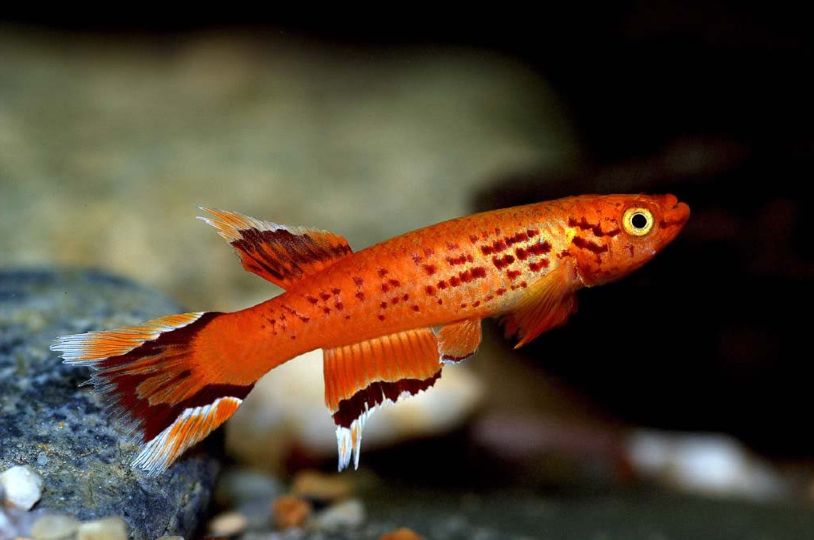
This popular fish is from West Africa, where it inhabits in small streams and ponds. The fish is about 5-6 cm long. The male fish has a lyre-shaped caudal fin which makes it easy to see between the male and female fish. To keep this fish you’ll need soft and acidic water in the tank.
Fundulopanchax (Aphyosemion gardneri)
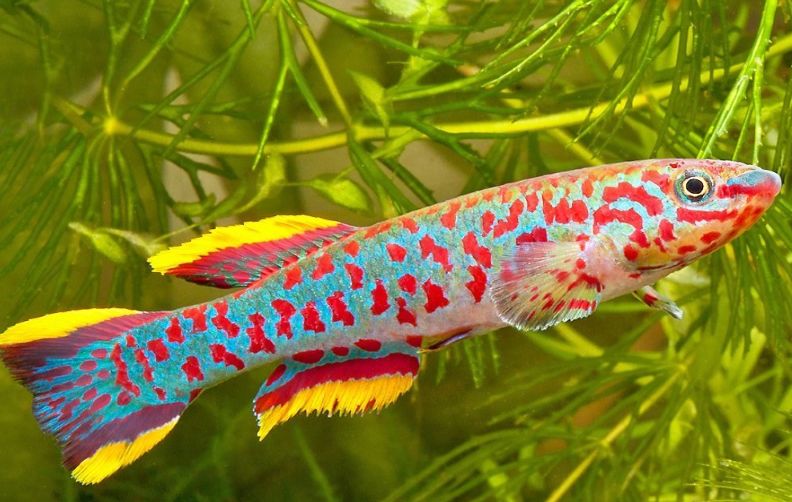
This is maybe one of the most renowned and popular pheasants fish species. It inhabits in West Africa. The fish can be up to 7 cm long. It has two color morphs: yellow and blue one.
Malabar killi (Aplocheilus lineatus)
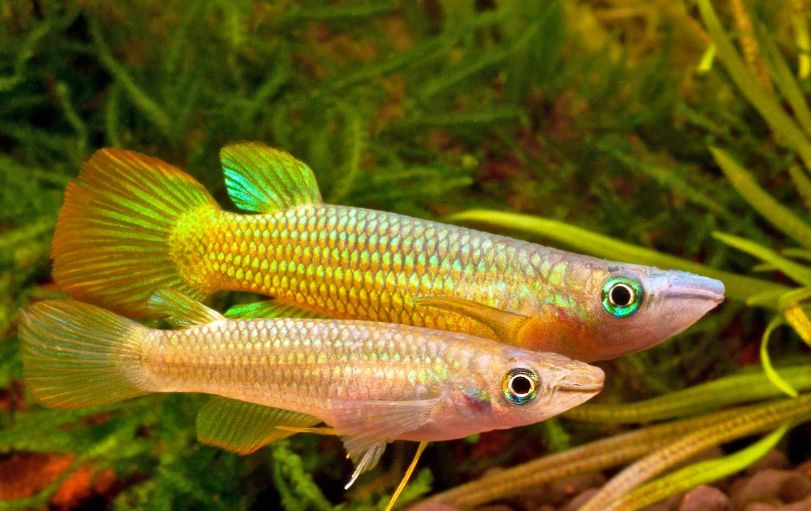
This is rather undemanding fish that comes from India. It can grow to be 10 cm long. The fish can dwell in a community tank, but it can also prey on small sized fish and fish juveniles.
Twostripe lyretail (Aphyosemion bivittatum)
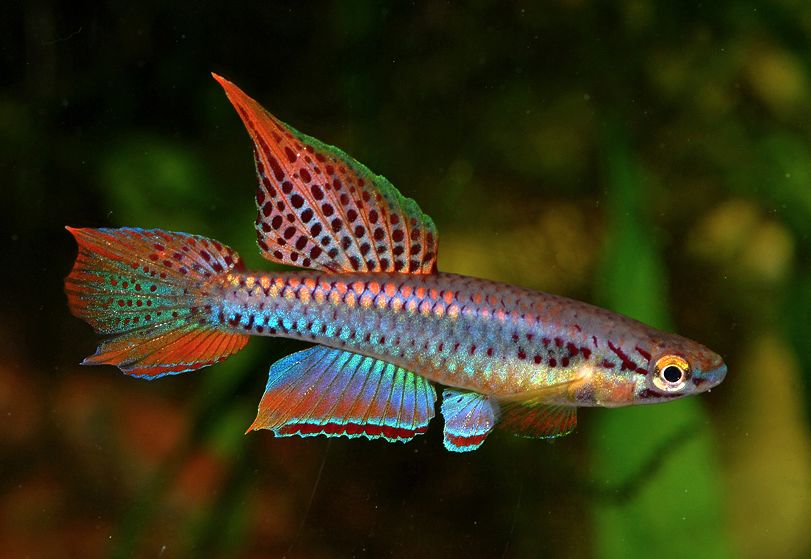
This killifish kind inhabits in West Africa and grows up to 5 cm long. If compared to other lyretail species, the twostripe one has rather poor coloring and it has rounded tail peculiar to the kind.
Bluefin Notho (Nothobranchius Rachovii)
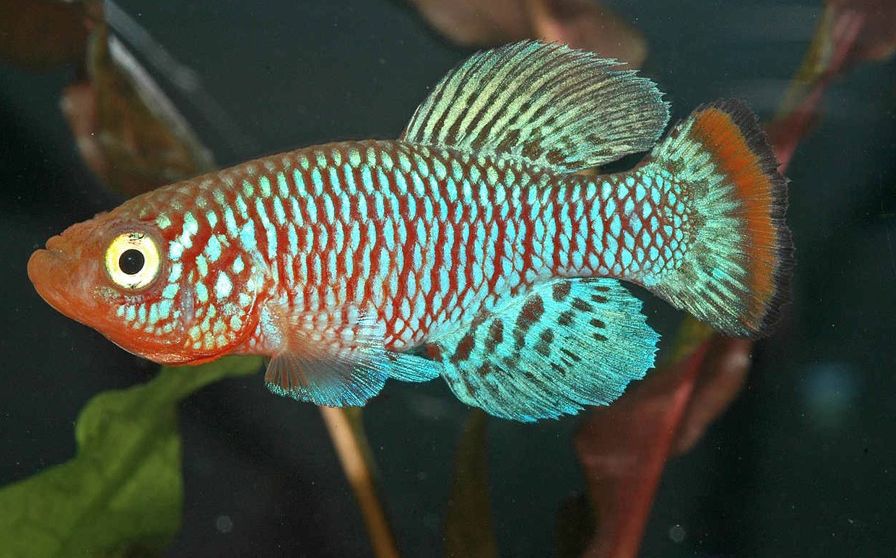
The fish dwells in Africa, Mozambique. It is up to 6 cm long. This is one of the brightest freshwater aquarium fishes, which makes it rather popular among the killifish fans.